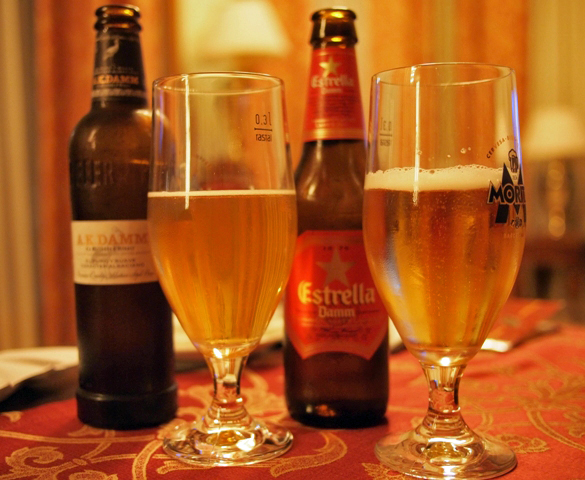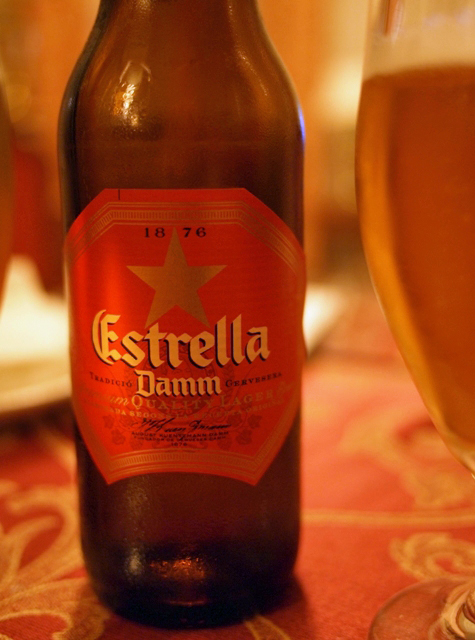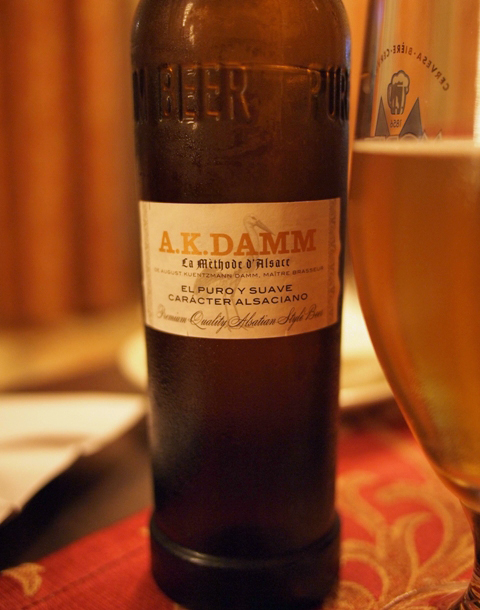Travels in Beer - Spain
 Tuesday, October 18, 2011 at 8:00
Tuesday, October 18, 2011 at 8:00 We ended our recent hiking trip through the Pyrennees with some tapas and Spanish beer at our hotel in Barcelona.
Since our hotel was located around the corner from the Damm brewery, it was only fitting that we tried two of their offerings.

We had seen Estrella Damm often (on all of the umbrellas and chairs at many cafes!) but had never heard of the AK Damm. Since our waitress couldn't tell us anything about the differences, we decided to try one of each.

Herr J had the standard Estrella Damm, which is pretty similar to other mass-produced lagers. While it was a notch above Budweiser in taste, it's pretty much Spain's Bud (or Budvar, if we want to stay in Europe). A reliably decent beer that you can get everywhere.
Interesting we make the comparison...Damm actually is Spain's licensed producer of Budweiser. While they are not owned by InBev, they are in a partnership (to produce Bud).
The S.A. Damm brewery has been in Barcelona for around 130 years, and is one of Spain's largest producers. They have a pretty wide variety in the beer assortment. We definitely see some German influence, as they include Märzen, Kellerbier, weissbier, and Bock styles, as well as a Radler! Given that Spain is the land of tinto de verano (red wine + sprite as a summer drink), it's only fitting that they have radlers....

The A.K. Damm, on the other hand, was a bit more interesting. We had no idea what to expect, but were pleasantly surprised by its smooth, light taste and almost a tingle on the tongue. While it was light and crisp, it also had some of the caramel notes of a darker, maltier beer. And it was not clear, but had no sediment. We really weren't sure where to classify this beer, but it's probably closest to a helles, with a little more malt. Part of me felt it leaned toward a weissbier, but it clearly was not one.
The bottle describes the beer as being brewed according to the Alsatian method, and combining German character with French refinement. Named after the Damm founder August Kuentzmann Damm, it was released in 2001 to celebrate the brewery's 125th anniversary. It uses the original beer recipe that he brought with him when he moved from Strasbourg to Barcelona in 1876.
We're not quite sure what the Alsatian method is, but it appears to be brewed according to reinheitsgebot standards and is called a "pure malt beer" that uses the barley and hops from the Alsace. Alsace is France's main beer brewing and hops-growing region, with a strong German influence. We could definitely enjoy this beer with a nice flammkuchen!
While we quite enjoyed its light and unique taste, this beer does not get good reviews on most beer rating sites. We suspect that this is driven by one of two factors:
1) Preference - it seems the typical person who rates beers on these sites prefers a strong hoppy or dark or bitter beer. The smoother, sweeter beers generally are not well-rated.
2) The Hofbräu Effect - We coined this term during our beer tournament. When asked what they think about Hofbräu beer, most Munich residents gave a thumbs down. But in blind tastings, it was well-liked. (The same was true for Löwenbräu). So, we suspect this beer lost several points just for being a Spanish beer and would have fared better in blind tastings.
While we're the first to admit that we're biased towards Helles and less hoppy beers, we really enjoyed this one and will definitely order it again next time we're in Spain.
And as a bonus, we're now inspired to go visit the Alsace and check out their beers!
 Frau A ...
Frau A ...  2 Comments
2 Comments 



